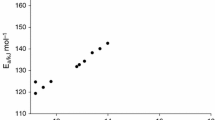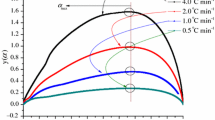Abstract
Decomposition onset temperature and heat of decomposition are two important parameters for assessment of thermal stability of an energetic compound. This study presents two new correlations for predicting decomposition onset temperature and heat of decomposition of organic peroxides through their molecular structures. For 33 organic peroxides with different molecular structures, the new model for decomposition onset temperature gives the root-mean-square (rms) and the average absolute (σ) deviations 6.06 and 5.18 °C, respectively. The values of rms and σ deviations for heat of decomposition are also 146.41 and 118.19 J g−1, respectively. The proposed new models give good predictions for further eight organic peroxides containing complex molecular structures. The predicted results have also given more reliable results as compared to two of the best available methods, which are based on complex quantum mechanical parameters. High reliability of the new methods has been confirmed statistically by internal and external validation methods.


Similar content being viewed by others
References
Klapötke TM. Chemistry of high-energy materials. 3rd ed. Berlin: De Gruyter; 2015.
Agrawal JP. High energy materials: propellants, explosives and pyrotechnics. Weinheim: WILEY-VCH Verlag GmbH & Co. KGaA; 2010.
Pilar R, Pachman J, Matyáš R, Honcová P, Honc D. Comparison of heat capacity of solid explosives by DSC and group contribution methods. J Therm Anal Calorim. 2015;121(2):683–9.
Pourmortazavi SM, Sadri M, Rahimi-Nasrabadi M, Shamsipur M, Jabbarzade Y, Khalaki MS, et al. Thermal decomposition kinetics of electrospun azidodeoxy cellulose nitrate and polyurethane nanofibers. J Therm Anal Calorim. 2015;119(1):281–90.
Pouretedal H, Ravanbod M. Kinetic study of ignition of Mg/NaNO3 pyrotechnic using non-isothermal TG/DSC technique. J Therm Anal Calorim. 2015;119(3):2281–8.
Yan QL, Zeman S. Theoretical evaluation of sensitivity and thermal stability for high explosives based on quantum chemistry methods: a brief review. Int J Quantum Chem. 2013;113(8):1049–61.
Badgujar D, Talawar M, Asthana S, Mahulikar P. Advances in science and technology of modern energetic materials: an overview. J Hazard Mater. 2008;151(2):289–305.
Talawar M, Sivabalan R, Mukundan T, Muthurajan H, Sikder A, Gandhe B, et al. Environmentally compatible next generation green energetic materials (GEMs). J Hazard Mater. 2009;161(2):589–607.
Keshavarz MH, Moradi S, Saatluo BE, Rahimi H, Madram AR. A simple accurate model for prediction of deflagration temperature of energetic compounds. J Therm Anal Calorim. 2013;112(3):1453–63.
Keshavarz MH, Ghani K, Asgari A. A new method for predicting heats of decomposition of nitroaromatics. Zeitschrift für anorganische und allgemeine Chemie. 2015;641(10):1818–23.
Keshavarz MH, Ghani K, Asgari A. A suitable computer code for prediction of sublimation energy and deflagration temperature of energetic materials. J Therm Anal Calorim. 2015;121(2):675–81.
Keshavarz MH, Motamedoshariati H, Moghayadnia R, Ghanbarzadeh M, Azarniamehraban J. A new computer code for assessment of energetic materials with crystal density, condensed phase enthalpy of formation, and activation energy of thermolysis. Propellants Explos Pyrotech. 2013;38(1):95–102.
Chen ZX, Xiao HM. Quantum chemistry derived criteria for impact sensitivity. Propellants Explos Pyrotech. 2014;39(4):487–95.
Fang-qiang Y, Cong-zhong C, Shuai Z. Prediction of impact sensitivity of nitro energetic compounds by using structural parameters. Explos Shock Waves. 2013;1:012.
Fayet G, Rotureau P. Development of simple QSPR models for the impact sensitivity of nitramines. J Loss Prev Process Ind. 2014;30:1–8.
Keshavarz MH. A new general correlation for predicting impact sensitivity of energetic compounds. Propellants Explos Pyrotech. 2013;38(6):754–60.
Keshavarz MH, Motamedoshariati H, Pouretedal HR, Tehrani MK, Semnani A. Prediction of shock sensitivity of explosives based on small-scale gap test. J Hazard Mater. 2007;145(1):109–12.
Keshavarz MH, Hayati M, Ghariban-Lavasani S, Zohari N. A new method for predicting the friction sensitivity of nitramines. Central Eur J Energ Mater. 2015;12(2):215–27.
Wang R, Sun L, Kang Q, Li Z. Predicting the electric spark sensitivity of nitramines from molecular structures via support vector machine. J Loss Prev Process Ind. 2013;26(6):1193–7.
Keshavarz MH. Theoretical prediction of electric spark sensitivity of nitroaromatic energetic compounds based on molecular structure. J Hazard Mater. 2008;153(1):201–6.
Zohari N, Keshavarz MH, Seyedsadjadi SA. A link between impact sensitivity of energetic compounds and their activation energies of thermal decomposition. J Therm Anal Calorim. 2014;117(1):423–32.
Zohari N, Keshavarz MH, Seyedsadjadi SA. A novel method for risk assessment of electrostatic sensitivity of nitroaromatics through their activation energies of thermal decomposition. J Therm Anal Calorim. 2014;115(1):93–100.
Keshavarz MH, Zohari N, Seyedsadjadi SA. Relationship between electric spark sensitivity and activation energy of the thermal decomposition of nitramines for safety measures in industrial processes. J Loss Prev Process Ind. 2013;26(6):1452–6.
Keshavarz MH, Hayati M, Ghariban-Lavasani S, Zohari N. Relationship between activation energy of thermolysis and friction sensitivity of cyclic and acyclic nitramines. Zeitschrift für anorganische und allgemeine Chemie. 2016;642(2):182–8.
Matyáš R, Pachman J. Organic peroxides. In: Primary explosives. Berlin: Springer; 2013. p. 255–87.
Benassi R, Folli U, Sbardellati S, Taddei F. Conformational properties and homolytic bond cleavage of organic peroxides. I. An empirical approach based upon molecular mechanics and ab initio calculations. J Comput Chem. 1993;14(4):379–91.
Smith MB, March J. March’s advanced organic chemistry: reactions, mechanisms, and structure. Berlin: Wiley; 2007.
Benassi R, Taddei F. Homolytic bond-dissociation in peroxides, peroxyacids, peroxyesters and related radicals: ab initio MO calculations. Tetrahedron. 1994;50(16):4795–810.
Chang R, Tseng J, Jehng J, Shu C, Hou H. Thermokinetic model simulations for methyl ethyl ketone peroxide contaminated with H2SO4 or NaOH by DSC and VSP2. J Therm Anal Calorim. 2006;83(1):57–62.
Tsai L-C, You M-L, Ding M-F, Shu C-M. Thermal hazard evaluation of lauroyl peroxide mixed with nitric acid. Molecules. 2012;17(7):8056–67.
CSB, HI. Improving reactive hazard management. Washington, DC: US Chemical Safety and Hazard Investigation Board; 2002.
Ho TC, Duh YS, Chen J. Case studies of incidents in runaway reactions and emergency relief. Process Saf Prog. 1998;17(4):259–62.
Kletz TA. Fires and explosions of hydrocarbon oxidation plants. Plant/Oper Prog. 1988;7(4):226–30.
Martin JJ. SAFETY—tert-Butyl peracetate—an explosive compound. Ind Eng Chem. 1960;52(4):65A–8A.
Wakakura M, Iiduka Y. Trends in chemical hazards in Japan. J Loss Prev Process Ind. 1999;12(1):79–84.
Noller D, Mazurowski S, Linden G, De Leeuw F, Mageli O. A relative hazard classification of organic peroxides. Ind Eng Chem. 1964;56(12):18–27.
Gao Y, Xue Y, Lǚ Z-g, Wang Z, Chen Q, Shi N, et al. Self-accelerating decomposition temperature and quantitative structure–property relationship of organic peroxides. Process Saf Environ Prot. 2015;94:322–8.
Lu Y, Ng D, Mannan MS. Prediction of the reactivity hazards for organic peroxides using the QSPR approach. Ind Eng Chem Res. 2010;50(3):1515–22.
Pan Y, Zhang Y, Jiang J, Ding L. Prediction of the self-accelerating decomposition temperature of organic peroxides using the quantitative structure–property relationship (QSPR) approach. J Loss Prev Process Ind. 2014;31:41–9.
Prana V, Rotureau P, Fayet G, André D, Hub S, Vicot P, et al. Prediction of the thermal decomposition of organic peroxides by validated QSPR models. J Hazard Mater. 2014;276:216–24.
Her B, Jones A, Wollack JW. A three-step synthesis of benzoyl peroxide. J Chem Educ. 2014;91(9):1491–4.
Li X-R, Koseki H. Thermal decomposition kinetic of liquid organic peroxides. J Loss Prev Process Ind. 2005;18(4):460–4.
Malow M, Wehrstedt K. Prediction of the self-accelerating decomposition temperature (SADT) for liquid organic peroxides from differential scanning calorimetry (DSC) measurements. J Hazard Mater. 2005;120(1):21–4.
Saraf S, Rogers W, Mannan MS. Prediction of reactive hazards based on molecular structure. J Hazard Mater. 2003;98(1):15–29.
Pourmortazavi SM, Rahimi-Nasrabadi M, Kohsari I, Hajimirsadeghi SS. Non-isothermal kinetic studies on thermal decomposition of energetic materials: KNF and NTO. J Therm Anal Calorim. 2011;110(2):857–63.
Keshavarz MH, Zohari N, Seyedsadjadi SA. Validation of improved simple method for prediction of activation energy of the thermal decomposition of energetic compounds. J Therm Anal Calorim. 2013;114(2):497–510.
Pandele Cusu J, Musuc AM, Matache M, Oancea D. Kinetics of exothermal decomposition of some. J Therm Anal Calorim. 2011;110(3):1259–66.
Krabbendam-LaHaye E, De Klerk W, Krämer R. The kinetic behaviour and thermal stability of commercially available explosives. J Therm Anal Calorim. 2005;80(2):495–501.
Bunyan P, Baker C, Turner N. Application of heat conduction calorimetry to high explosives. Thermochim Acta. 2003;401(1):9–16.
Keshavarz MH. Simple method for prediction of activation energies of the thermal decomposition of nitramines. J Hazard Mater. 2009;162(2):1557–62.
Keshavarz MH, Pouretedal HR, Shokrolahi A, Zali A, Semnani A. Predicting activation energy of thermolysis of polynitro arenes through molecular structure. J Hazard Mater. 2008;160(1):142–7.
Keshavarz M. A new method to predict activation energies of nitroparaffins. Indian J Eng Mater Sci. 2009;16(6):429.
Gharagheizi F, Sattari M, Ilani-Kashkouli P, Mohammadi AH, Ramjugernath D, Richon D. Quantitative structure—property relationship for thermal decomposition temperature of ionic liquids. Chem Eng Sci. 2012;84:557–63.
Zhang Q. Shreeve JnM. Energetic ionic liquids as explosives and propellant fuels: a new journey of ionic liquid chemistry. Chem Rev. 2014;114(20):10527–74.
Wang Q, Wang J, Larranaga MD. Simple relationship for predicting onset temperatures of nitro compounds in thermal explosions. J Therm Anal Calorim. 2013;111(2):1033–7.
Keshavarz M, Pouretedal H, Semnani A. Relationship between thermal stability and molecular structure of polynitro arenes. Indian J Eng Mater Sci. 2009;16(1):61.
Yang T, Chen L, Chen W, Zhou Y, Gao H, Zhong T. Thermal stability of 2-ethylhexyl nitrate with acid. J Therm Anal Calorim. 2015;119(1):205–12.
Xing X, Zhao S, Huang W, Li W, Zhang W, Diao X, et al. Thermal decomposition behavior of hexanitrohexaazaisowurtzitane and its blending with BTATz (expand) and Al by microcalorimetry. J Therm Anal Calorim. 2015;120(2):1393–7.
Pilar R, Pachman J, Matyáš R, Honcová P, Honc D. Comparison of heat capacity of solid explosives by DSC and group contribution methods. J Therm Anal Calorim. 2015;121(2):683–9.
Xiao L-B, Zhao F-Q, Luo Y, Gao H-X, Li N, Meng Z-H et al. Thermal behavior and safety of 4, 10-dinitro-2, 6, 8, 12-tetraoxa-4, 10-diazaisowutrzitane. J Therm Anal Calorim. 2015;121(2):839–42.
Huang H, Shi Y, Yang J. Thermal characterization of the promising energetic material TKX-50. J Therm Anal Calorim. 2015;121(2):705–9.
Künzel M, Yan Q-L, Šelešovský J, Zeman S, Matyáš R. Thermal behavior and decomposition kinetics of ETN and its mixtures with PETN and RDX. J Therm Anal Calorim. 2014;115(1):289–99.
Fischer D, Klapötke TM, Stierstorfer J. Oxalylhydrazinium nitrate and dinitrate—efficiency meets performance. J Energ Mater. 2014;32(1):37–49.
Klapötke TM. Chemistry of high-energy materials. Berlin: Walter de Gruyter; 2012.
Agrawal JP, Hodgson R. Organic chemistry of explosives. Chichester: Wiley; 2007.
Felix SP, Singh G, Sikder A, Aggrawal J. Studies on energetic compounds: Part 33: thermolysis of keto-RDX and its plastic bonded explosives containing thermally stable polymers. Thermochim Acta. 2005;426(1):53–60.
Sikder A, Sikder N. A review of advanced high performance, insensitive and thermally stable energetic materials emerging for military and space applications. J Hazard Mater. 2004;112(1):1–15.
Talawar M, Jangid S, Nath T, Sinha R, Asthana S. New directions in the science and technology of advanced sheet explosive formulations and the key energetic materials used in the processing of sheet explosives: Emerging trends. J Hazard Mater. 2015;300:307–21.
Palm WJ. Introduction to MATLAB 7 for engineers. New York: McGraw-Hill; 2005.
Khozani MH, Keshavarz MH, Nazari B, Mohebbi M. Simple approach for prediction of melting points of organic molecules containing hazardous peroxide bonds. J Iran Chem Soc. 2015;12(4):587–98.
Gramatica P. Principles of QSAR models validation: internal and external. QSAR Comb Sci. 2007;26(5):694.
Tropsha A. Best practices for QSAR model development, validation, and exploitation. Mol Inf. 2010;29(6–7):476–88.
Acknowledgements
We would like to thank the research committee of Malek-Ashtar University of Technology (MUT) for supporting this work.
Author information
Authors and Affiliations
Corresponding authors
Rights and permissions
About this article
Cite this article
Zohari, N., Keshavarz, M.H. & Dalaei, Z. Prediction of decomposition onset temperature and heat of decomposition of organic peroxides using simple approaches. J Therm Anal Calorim 125, 887–896 (2016). https://doi.org/10.1007/s10973-016-5451-5
Received:
Accepted:
Published:
Issue Date:
DOI: https://doi.org/10.1007/s10973-016-5451-5




